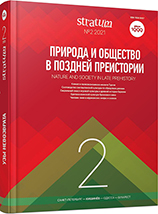Об искусственной деформации черепов степных культур эпохи бронзы
On the Artificial Deformation of Skulls of Steppe Cultures of the Bronze Age
Author(s): Aleksey A. Kazarnitsky, Julia O. Kapinus, Artem P. GrigoryevSubject(s): History, Archaeology, Customs / Folklore, Cultural Anthropology / Ethnology
Published by: Издательский дом Stratum, Университет «Высшая антропологическая школа»
Keywords: steppes of Eastern Europe; Bronze Age; artificial deformation of skulls; geometric morphometrics; craniology; physical anthropology;
Summary/Abstract: Artificial cranial deformation is known among the steppe Bronze Age population. This tradition again pervaded in the steppes of Eastern Europe burials in the first centuries AD after thousands of years. The authors investigate the sagittal contours of deformed skulls using geometric morphometric methods. The skulls from sites located in the Northwest Caspian dated by the Early and Middle Bronze Age have been analysed. In addition, the authors investigated deformed skulls from the northeastern periphery of the Catacomb culture (the Bronze Age) and from the Late Sarmatian sites (Late Antiquity). It has been established that low variation of the occipital-parietal cranial flattening had characterized population of the Yamnaya, Yamnaya-Catacomb and Early Catacomb cultures of the Northwest Caspian. Other type of cranial deformation, more variable, occurred among the population of Vostochnomanychskaya Catacomb culture: neurocranium was increased in height and reduced in length. This tradition was widespread on the southern territories of the Catacomb cultural historical community, it was also observed in its northeastern periphery, but less often and not quite the same. A comparison showed distinct differences between the sagittal contours of the deformed skulls of the Catacomb and Late Sarmatian cultures.
Journal: Stratum plus. Археология и культурная антропология
- Issue Year: 2021
- Issue No: 2
- Page Range: 307-318
- Page Count: 12
- Language: Russian
- Content File-PDF

